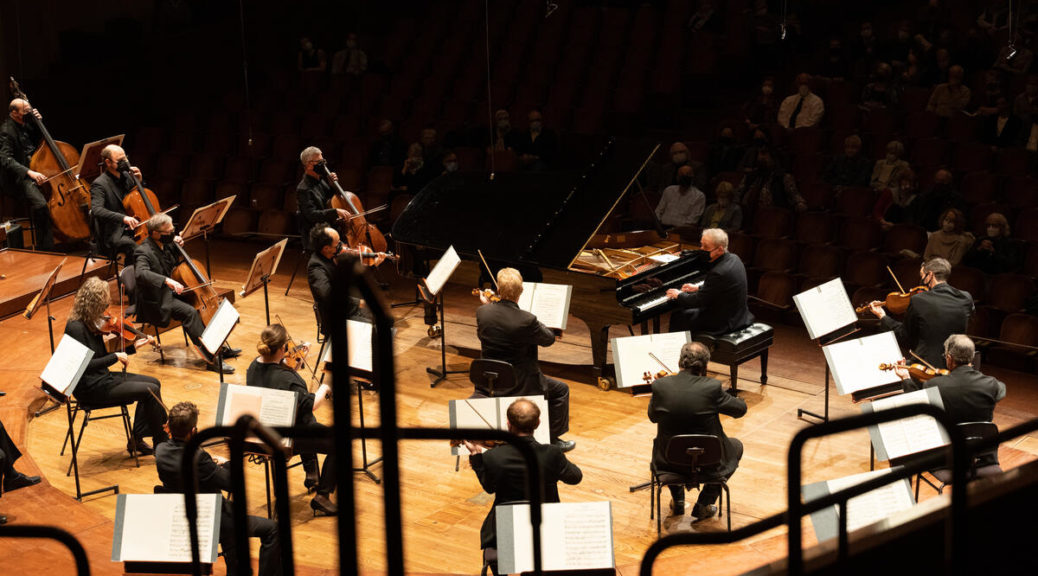
MANY HAPPY RETURNS TO SYMPHONIC MUSIC
It was like returning to Earth, after 14 months in viral space, floating isolated in great voids between Mars and Jupiter.
The reentry into a real concert hall, in person, with live musicians on stage—-Bliss!! The reduced Davies Hall crowd applauded enthusiastically for 20 seconds at the start, so moved by a cautious return to real musical life.
It was far from normal. Some two dozen San Francisco Symphony string players were on stage, all masked and separated, devoid of wind players (as their breath spreads viruses). No formal attire, no podium, no printed program, no intermission, and everything including length scaled down. Out front: no drinking fountain, no store, no bar, and reams of empty seats by order of health authorities.
But this time, instead of the virus wiping out symphonic music, it was the S.F. Symphony courageously striking back phoenix-like at the virus. High time!
The catalyst for this reprise was Jeremy Denk, the deft resourceful pianist nowadays also active as conductor and artistic director. The gregarious Denk led from the piano keyboard, a la Leonard Bernstein, in four works of an intimacy rarely encountered here. He dedicated the concluding Mozart Piano Concerto (No. 14) to the SFS wind players, still cooling their heels in the wings, waiting, waiting, waiting for their return to Earth.
The concerto was the highlight. In the cadenzas (display solo segments) Denk used the full resources of the modern concert grand contrasting with the former Mozart fortepianos, playing with panache and dynamic verve, plus some provocative pauses. The players, including some but not all of the principals, came through with accustomed consistency.
Opening the program was an astute choice of “Out of the Silence” by William Grant Still, the pioneering African-American composer of the 20th century. The to-and-fro of the music suggested lapping waves of some Debussyan lake, with piano segments interspersed. Still’s story was one of overcoming deprivation. He never finished college, worked as a janitor at the Oberlin Conservatory, benefited from composition instruction given him at no charge, and, in 1939, even had to cross into Mexico to get married because of US taboos on interracial marriage. Among his firsts as a Black were the first to conduct a major American symphony orchestra, the first to have a symphony performed by a leading orchestra, the first to have an opera performed by a major opera company and performed on national TV.
Between these musical columns came Gerald Finzi’s trifling “Eclogue” and Bach’s rather grand Keyboard Concerto No. 1, in which Denk will be forgiven for subbing the piano for Bach’s traditional harpsichord.
Responding to prolonged applause by patrons profoundly grateful for the renaissance of live concert music, Denk performed a whiz-bang piano solo invention by Donald Lambert based on Richard Wagner’s “Pilgrim’s Chorus,” ranging into jazz harmonies and the flamboyance recalling the heady days of Vladimir Horowitz.
MUSIC NOTES—Patrons were not permitted entry except with virus-free evidence, ID, mask and either ticket or proper QR code on smartphone. Only a minority of the seats were eligible for sale because of distance-spacing, which meant that the plucky management lost considerably more income per concert than in the “good old days.” Next stop: fund-raising.
SAN FRANCISCO SYMPHONY string section in concerts under conductor-pianist Jeremy Denk at Davies Hall, S.F., through May 14, 7 pm. For SFS info, call (415) 864-6000 or go online: www.sfsymphony.org.